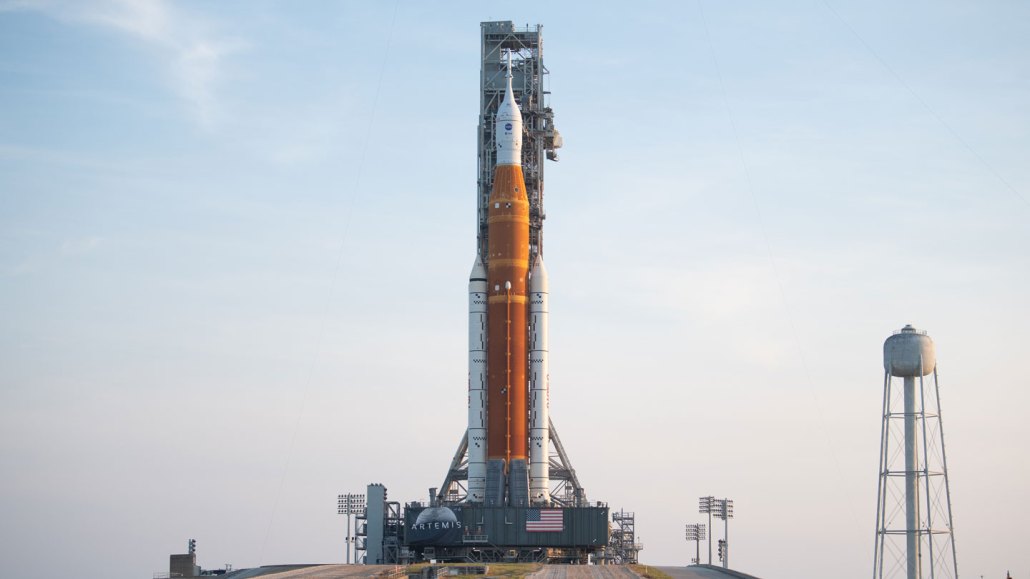
NASA’s Space Launch System rocket and the Orion spacecraft get ready for launch from Kennedy Space Center in Florida.
Joel Kowsky/NASA
When Artemis I blasts off into the sky over Florida, it may launch a new era of lunar science and exploration with it.
The NASA mission, now scheduled to launch in September after a scrubbed first attempt, is the first of three planned flights aimed at landing humans on the moon for the first time since 1972. No astronauts will fly on the upcoming mission. But the flight marks the first test of the technology — the rocket, the spacesuits, the watery return to Earth — that will ultimately take people, including the first woman and the first astronaut of color, to the lunar surface.
The test includes the first flight of NASA’s Space Launch System, or SLS, and its Orion spacecraft, a rocket and crew capsule that have been decades in the making. These craft have been delayed, blown through their budgets and been threatened with cancellation more than once. Even within the spaceflight community, a lot of people feared they would never fly.
To see a human-capable moon rocket finally on the launchpad is “pretty astonishing,” says Casey Dreier, a Seattle-based space policy expert at the Planetary Society. “This is a reality that most of us alive on Earth today have never experienced.”
And if the Artemis program works, opportunities for science will follow.
“Because humans have to come back, alive, you have a huge opportunity to bring samples back with you,” Dreier says. Sending human astronauts may be a wedge to open the door for pure learning.
The launch
Artemis I was slated to lift off on August 29 at 8:33 a.m. EDT, but trouble with one of its engines led NASA to cancel that attempt. The launch attempt on September 3 was also scrubbed. The next opportunity to launch could be in late September.
When it does blast off, the SLS rocket will lift Orion into space, where the crew capsule will separate from the rocket and continue to an orbit around the moon. After circling the moon for about two weeks, Orion will slingshot back to Earth and splash down in the Pacific Ocean off the coast of San Diego. The whole mission will last about 42 days.
Orion will stay in space longer than any other human-rated spacecraft has without docking to another spaceship, like the International Space Station. At its closest approach, the spacecraft will fly about 100 kilometers above the lunar surface. It will also go up to 64,000 kilometers past the moon, farther from Earth than any spacecraft built for humans. The previous record, set by Apollo 13 in 1970, was 16,000 kilometers beyond the far side of the moon.
Lunar liaison
The Orion spacecraft’s outbound trajectory (green) will take it about 100 kilometers from the moon’s surface (1) before looping around and going into lunar orbit (2). After about two weeks circling the moon (gray), the capsule will leave lunar orbit (3) and start its return trip to Earth (blue). On its way back, the spacecraft will fire its engine, buzz the moon one more time (4) and then coast back to Earth for a watery landing.
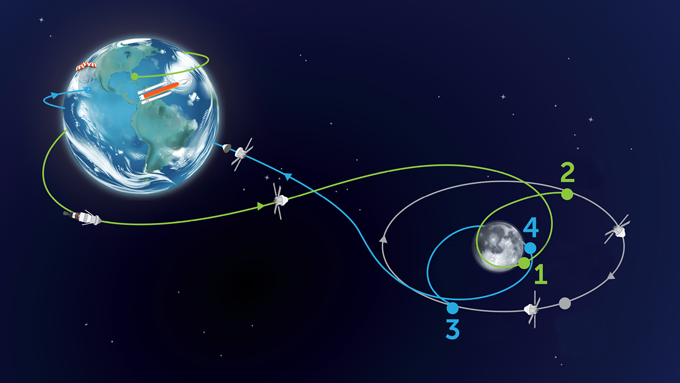
The main goal of the mission is to prove that everything works. That includes Orion’s heat shield, which will need to protect astronauts as the capsule comes screaming through Earth’s atmosphere at 40,000 kilometers per hour and heats up to more than 2700° Celsius on its return trip. It also includes the procedure for retrieving the capsule and its crew and cargo after splashdown.
Even though it has no astronauts, the mission won’t be flying empty. Just beneath the Orion capsule are 10 CubeSats, small, simple spacecraft each about the size of a shoebox. After Orion separates from the SLS rocket, those CubeSats will go their separate ways to study the moon, the radiation environment in space and the effects of that radiation on organisms like yeast. One CubeSat will unfurl a solar sail and take off to explore a near-Earth asteroid (SN: 8/26/11).
The “crew”
Inside the Orion capsule ride three humanoid passengers. In the commander’s seat is faux astronaut Moonikin Campos, named for Arturo Campos, a NASA engineer who played a key role in returning the Apollo 13 moon mission safely to Earth after its in-flight disaster in 1970. The “moonikin” — a mashup of moon and manikin — is based on a firefighter training rescue manikin, says NASA engineer Dustin Gohmert. Moonikin Campos will be wearing the new flight suit that was designed for the Artemis missions.
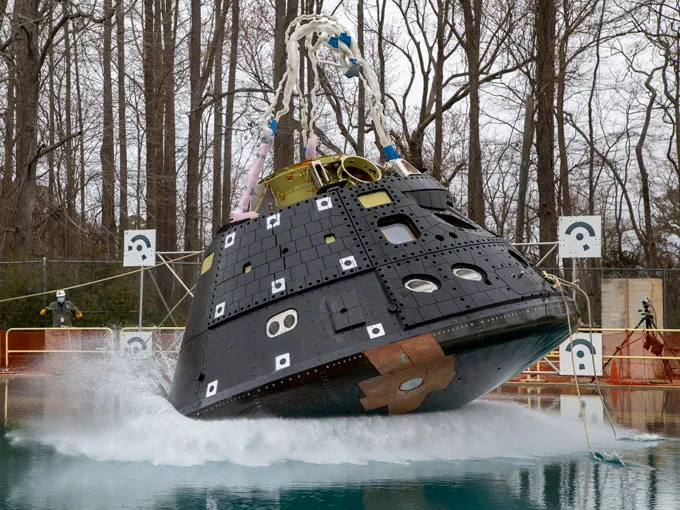
The spacesuit is like a personalized spacecraft, says Gohmert, of the Johnson Space Center in Houston, Texas. It’s meant to be worn during takeoff, landing and any time there is an emergency in the cabin. The suit may look familiar to anyone who watched space shuttle launches, Gohmert says, because it does a very similar job: “It’s an orange suit that acts like a balloon that’s shaped like your body.”
The main difference is that the Orion suit, plus the accompanying helmet, seat and connection to the Orion spacecraft itself, are designed to keep a crew member alive for up to six days, the time it could take to get back to Earth if something goes wrong in deep space. Astronauts visiting the International Space Station, by contrast, were never more than a few hours from Earth.
To help make that week tolerable, each suit will be custom fit to the astronaut. “I’d like to say the word ‘comfort,’ but that’s a difficult word to use,” Gohmert says. “Nothing will be comfortable about six days in a spacesuit, no matter what you do.”
The suit and spacecraft will provide the astronauts with oxygen and scrub the astronauts’ air of carbon dioxide. The suit will also have a tube for the astronauts to eat liquid food and a way for them to collect urine and feces, although Moonikin Campos won’t test those aspects. He will be equipped with radiation sensors, while his seat will have sensors to detect acceleration and vibration throughout the mission.
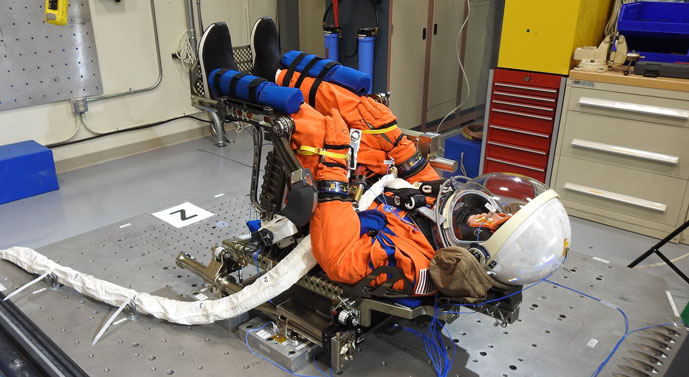
The suit, helmet and seat all take safety lessons from the space shuttle Columbia disaster, Gohmert says (SN: 9/22/2003). A junior engineer at the time, Gohmert worked on the suits the Columbia astronauts wore and saw the seven-member crew off to the launchpad. “It was a pivotal point for all of us, of course, who were there at the time,” he says. “If we didn’t take lessons from that, we wouldn’t be doing them justice.”
Moonikin Campos will be accompanied by a pair of mockup female torsos named Helga and Zohar. Their mission is to report back on space risks that are unique to female bodies, which have never been near the moon. NASA plans to send a woman on the first crewed Artemis flight, and women have different cancer risks from space radiation than men.
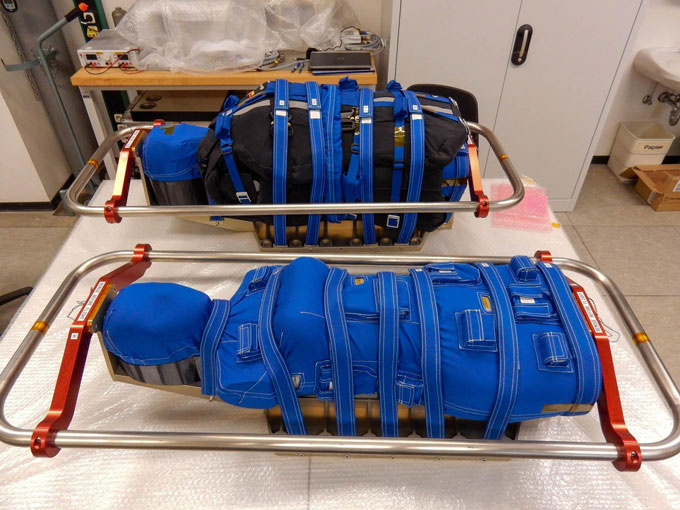
The two torsos are figures used in medicine called anthropomorphic phantoms, which are made from materials that simulate human bone, tissue and organs. “They are in principle identical twins,” said physicist Thomas Berger of the German Aerospace Center in Cologne in a briefing on August 17. But Zohar — whose name means “light” or “radiance” in Hebrew — will wear a radiation protection vest provided by the Israel Space Agency and the private company StemRad, based in Tampa, Fla.
The vest is made of a polymer designed to deflect protons that the sun releases during solar storms and has more shielding over radiation-sensitive organs like breasts and ovaries. Each phantom will also carry more than 6,000 small radiation detectors to build a 3-D picture of the dose of charged particles a female astronaut might receive on a trip to the moon and back. Comparing the radiation levels each phantom receives will help refine the vest’s design for future astronauts.
Orion will also carry two other nonhuman passengers — the British stop motion television character Shaun the sheep and Snoopy, who will serve as an indicator of zero gravity.
The past and the future
SLS and Orion have had a checkered history. The program goes back to 2004, when President George W. Bush proposed sending astronauts to the moon and then to Mars. In 2010, President Barack Obama canceled that plan, and then in 2017 President Donald Trump directed NASA to retrain its sights on the moon.
All the while, Congress continued to fund the development of the SLS rocket. Originally, SLS was supposed to cost $6 billion and fly in 2016. It has so far cost $23 billion on the eve of its launch in 2022.
“The rhetoric has flip-flopped a bunch,” Dreier says, as political leaders kept changing their vision for NASA’s direction. “But if you look at the actual programs, very little changed. … The whole time, the money was going to a moon rocket and a moon capsule.”
The next Artemis mission, Artemis II, is scheduled to launch in 2024 and take astronauts — real, live, human astronauts — around the moon but not to its surface.
Artemis III will be the moon landing mission. On August 19, NASA announced 13 candidate landing regions, all near the moon’s south pole, an intriguing spot that has never been visited by humans (SN: 11/11/18). That mission is scheduled to launch in 2025, but there are still a lot of untested elements. Those include the actual lander, which will be built by SpaceX.
There are still a lot of things that can go wrong and a long way to go. But the Artemis I launch is an optimistic dawn for lunar science nevertheless. “The whole [human spaceflight] system has all been shifting to point at the moon,” Dreier says. “I think that’s profoundly exciting. There’s going to be really interesting lessons that happen no matter what comes out of this.”







